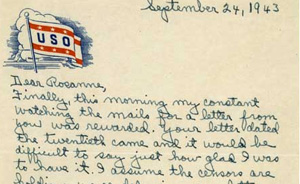talking history | syllabi | students | teachers | puzzle | about us
Battle Lines: Letters from America’s Wars,
http://www.gilderlehrman.org/collection/battlelines/index_good.html
Thirteen/WNET and the Gilder Lehrman Institute of American History.
Reviewed Feb. 2008.
Battle Lines is one of the many electronic exhibits featured on the Gilder Lehrman Institute of American History Web site. Like the larger site, Battle Lines is expertly organized and presented. The collection consists of letters between soldiers and their families organized thematically around five topics—enlisting, comforts of home, love, combat, and the end of war. Each theme is explored through six or seven letters written during one of America’s major conflicts. The collection is small but broad in its coverage and includes correspondence from the American Revolution, the War of 1812, the Civil War, World War I, World War II, the Korean War, the Vietnam War, the First Gulf War, and the current Iraq War. The site’s most novel feature is the audio recordings of the letters. Letters are read clearly and with reasonable approximations of accents, given that we do not have real audio recordings from earlier than the 1890s. Each letter is accompanied by a short biographical sketch and often a picture of the correspondent or another relevant historical image. Some of the letters are from well-known figures—such as Nathaniel Lee, Braxton Bragg, and Dwight D. Eisenhower—but many of the most affecting passages were penned by common soldiers, clerks, and their wives.

Detail of a letter from Melvin Purvis to Rosanne Purvis,
written on USO stationary in 1943.
The letters effectively convey the human dimensions of war and will make a fine teaching tool. They are an obvious fit for any class on military history but could also be used profitably in the U.S. history survey or any thematic or chronologically organized class where students explore America’s military conflicts. The audio recordings are ideal for classroom use because they offer teachers a chance to alter the medium of instruction and because they personalize the sources in a way that reading rarely does. The letters are viewable in their original format (many are owned by the Gilder Lehrman Collection). The site includes a sliding reader that can be dragged across the original letter image to reveal a transcription, though because these appear over the original text they can sometimes be hard to read. Full transcriptions from each letter can also be downloaded.
The letters reveal both the astuteness and the nearsightedness of soldiers serving in war zones. Some provide trenchant analyses of the dynamics of their situation, whether facing hostile civilians or enemy soldiers, while others focus solely on memories and thoughts of home. A 1942 Navy Department proposal to use bats to deliver small incendiary devices across Japan, included in the “combat” section, stands out as one of the more bizarre ideas in American military history. It also helps remind us of how uncertain the future was to those engaged in fighting. Wars are among those historical events most thoroughly clouded by hindsight, but the immediacy of the letters selected here reminds us of wars' contingent nature. The letters help demystify warfare without glorifying it. Even among the professional soldiers of the twentieth century, the letters invite an appreciation for the dilemmas faced by those who fight wars.
Aaron Sheehan-Dean
University of North Florida
Jacksonville, Florida
